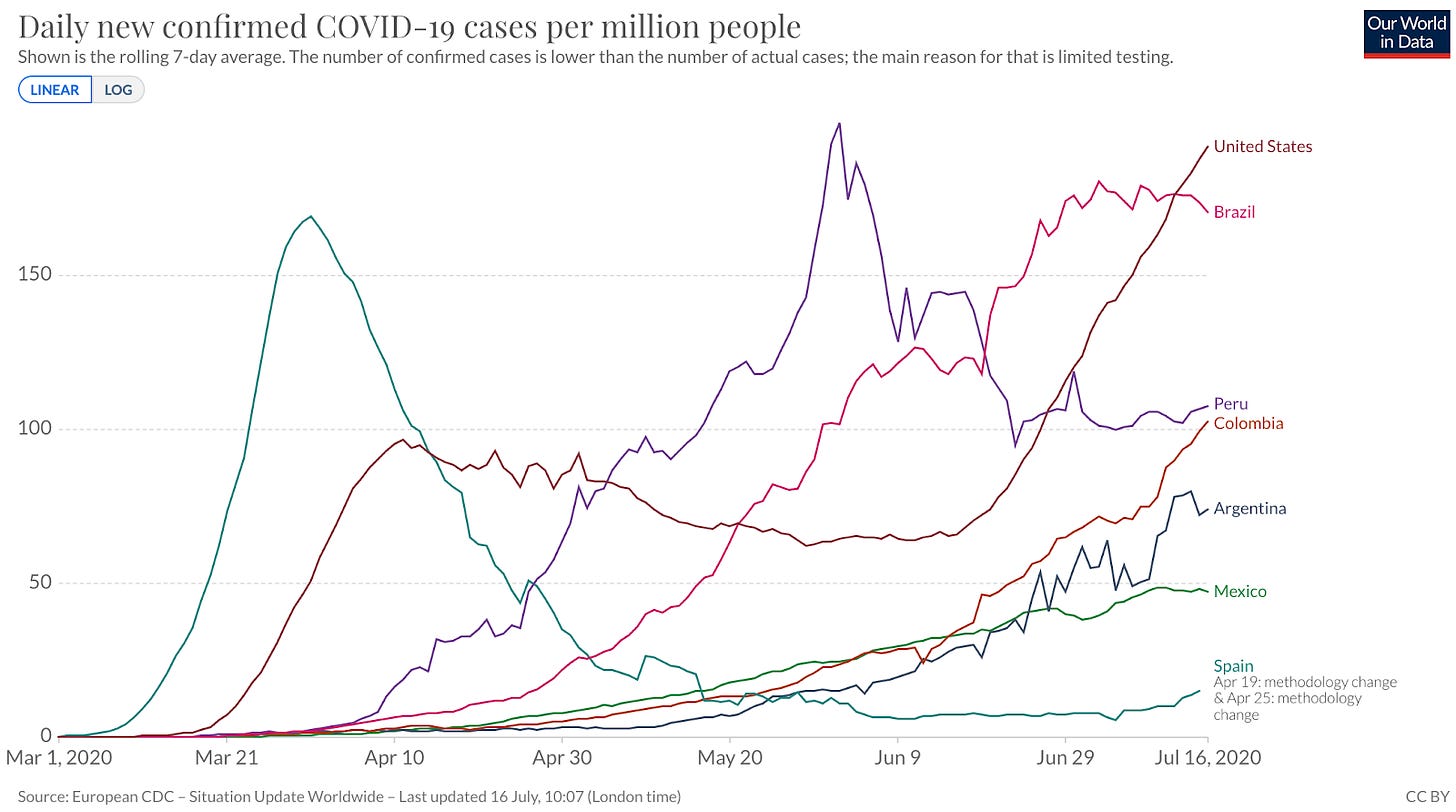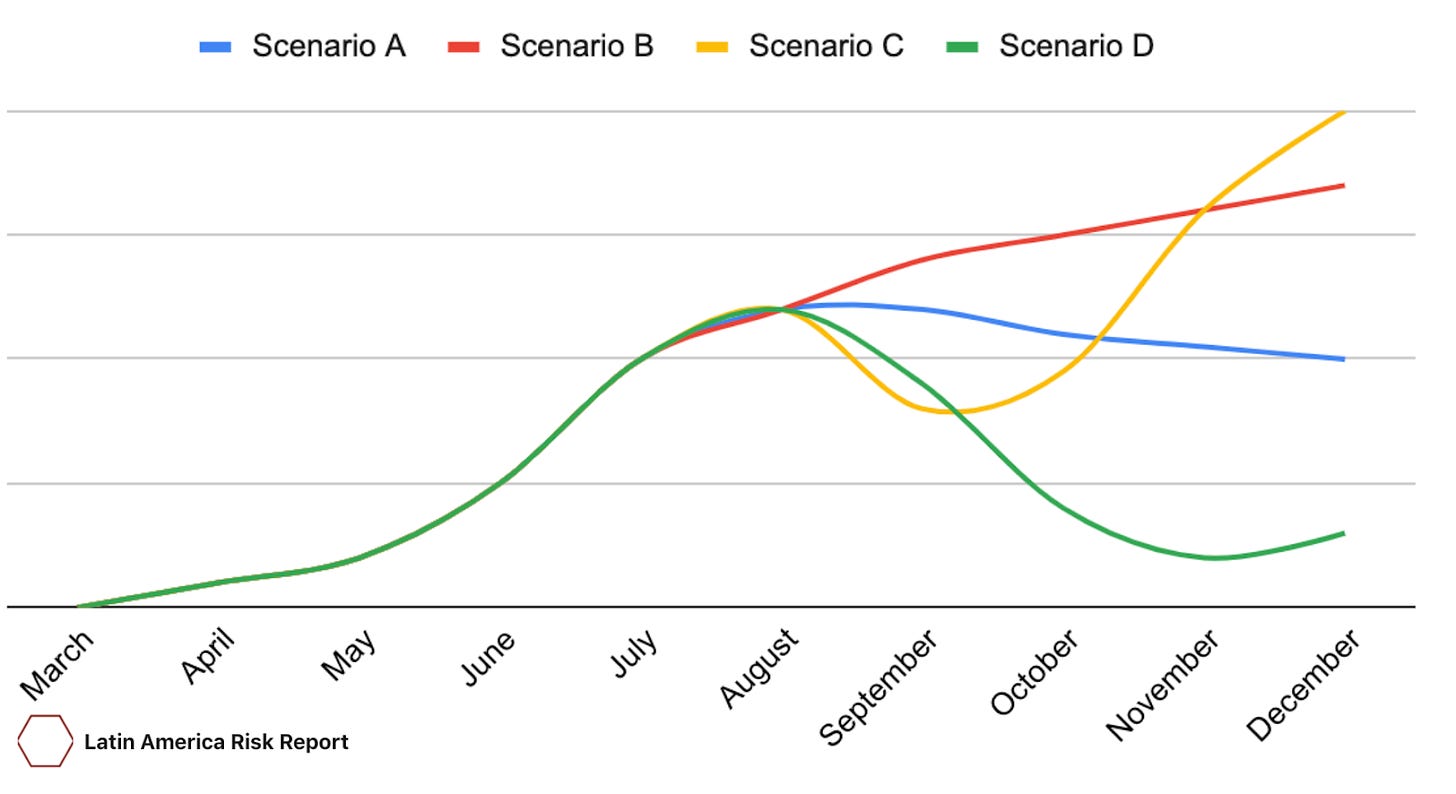Latin America Risk Report - 16 July 2020
Four coronavirus scenarios for Latin America suggest the most important months are yet to come

In today’s edition, I offer four scenarios for how coronavirus trends may play out in Latin America in the coming months.
I publish a free newsletter every Thursday. If you were forwarded this by email or found this newsletter on social media, please enter your email at https://boz.substack.com/ to receive this newsletter weekly.
I published three other newsletters this week:
Monday - An analysis on security in Central America
Tuesday - Thoughts on high level politicians being diagnosed with coronavirus (including JOH, Bolsonaro, Añez and Diosdado).
Wednesday - An update on politics and polls around the region including comments on Brazil, Guatemala and Suriname.
I’ve dropped the paywall on Tuesday’s post about politicians with coronavirus so everyone can access it now. Go ahead and go read it. If you want to support this newsletter and receive it four times per week instead of just on Thursdays, please consider subscribing at https://boz.substack.com/subscribe
Region - Rough months behind; rough months ahead
The next two months are more important to Latin America’s long term recovery than those months we’ve already gone through. In terms of the spread of coronavirus, based on the reported numbers of cases and levels of hospitalizations in many countries, August and September are going to be the most difficult months yet for much of Latin America. No country appears on the path to a quick recovery.
That’s a tough message for countries and populations that have gone through so much this year. However, it’s a message that presidents must deliver to their publics at the risk of the situation worsening.
Cases remain high in much of the region
The chart below (adjusted for population) shows the paths taken so far by Latin America’s most populous countries. I’ve included Spain and the United States for reference of two paths that Latin American countries have not experienced.

Above: Data from European CDC via Our World in Data
In most countries, Latin America’s cases continue to increase. In the few countries that have managed to see a decline in new cases, the numbers are still far too high to reopen safely. Meanwhile, hospital systems are increasingly strained and the region’s economies have taken significant hits. A swift economic rebound is unlikely.
Four scenarios for the months ahead
As a thought experiment, I have drawn out four paths that various Latin American countries may take in the coming months. In the chart below, the March through July line represents the linear growth for cases in a typical Latin American country so far (similar to the pattern for Brazil, Colombia or Argentina in the graph above). For the four scenarios I offer, to be clear, I am not applying any epidemiological model nor am I using real data. I’m just drawing lines on a chart and offering narratives as a way for readers to think through what may happen over the rest of 2020.

Scenarios A and B are variations on the status quo.
Scenario A suggests cases peak around July or August and then maintain those levels for much of the rest of the year. It’s a long plateau that likely requires economically difficult lockdown measures to maintain the current numbers without getting any improvements that would allow for a major economic reopening.
Scenario B suggests that the numbers of new cases steadily rise throughout the rest of the year with the region unable to contain the virus. This is what will occur if the region takes no new measures and de facto reopenings happen by the population, with governments unwilling to enforce harsh lockdowns against citizens in a no-win economic situation. There is no large spike in the numbers of reported cases, but there is also not a decline. If this occurs, hospital systems will be overwhelmed and the numbers of deaths will rise.
Scenarios C and D suggest that cases peak and then decline beginning in July or August. If that is the case, the big question is whether the countries reopen too quickly and without proper safety precautions.
Scenario C has countries that reopen too quickly spiking to even higher levels than before. Those countries would then have a hard time reimposing lockdowns. This scenario says the countries will experience a “Wave 1.5” similar to what the US is experiencing at the moment.
Scenario D is the most positive scenario of the four, with countries successfully reducing their cases and keeping them lower than current levels for the rest of the year. That scenario is the flattened curve, achieved at great economic cost. It allows Latin America, like Europe is now, to begin gradual reopenings in the fourth quarter of this year. Even in this best case scenario, the threat of new cases remains high.
The timing of the scenarios for each country may not match what I’ve outlined in the graph. Peru, for example, appears to have already entered scenario C or D, hitting its peak in cases in June. Colombia and Argentina may not peak until September.
The challenge is more than coronavirus fatigue
That thought experiment above is pessimistic. I haven’t tried to put percentage chances on each scenario yet (I’m looking forward to readers’ comments as I continue to work through this thought experiment). However, Scenarios A, B and C all seem to be very bad news. In all three, new case levels remain high and the population suffers significant losses.
The only positive path, Scenario D, is arguably the least likely in the region’s two largest countries (Mexico and Brazil) over the coming six months given the poor leadership seen so far. Even in the countries with more reasonable leaders, the challenges of maintaining policies to suppress the virus and reach Scenario D are significant.
We all have coronavirus fatigue. Governments have been working overtime, rewriting the crisis playbook on both health and economics. Citizens are tired of being told to stay at home.
But Latin America’s ability to reduce the number of cases back to manageable levels is about more than people simply lacking patience and disregarding scientific advice. Social safety nets and government stimulus efforts are not providing the minimal levels of support that many of the region’s poor and lower middle class need to survive. Those in the informal sector need daily income to feed their families and do not have the luxury of working from home. The poorest in the region also lack basic utilities and services in their homes (such as running water or refrigeration for food), forcing them out to interact with other people on a more regular basis and risk spreading the virus.
Much of the region is going through a de facto and unplanned economic reopening as people struggle to survive. Even governments that want to impose new lockdown measures will have a difficult time enforcing their rules against citizens whose choice is to risk infection or starve.
Corruption Corner
Mexico - President Lopez Obrador claimed there were numerous bribes that allowed the 2013 energy reform to pass the Congress during the previous administration. AMLO said the extradition of former Pemex head Emilio Lozoya may allow him to obtain additional evidence of corruption.
An article from Bloomberg suggests a renewed focus on the corruption that allegedly occurred during Peña Nieto’s energy reform allows AMLO to return to two of his favorite and most popular topics as he prepares for the mid-term elections next year. However, with many Mexican voters concerned about the economy and coronavirus, it is possible a focus on these issues from the previous administration may make the president appear out of touch.
There is also a concern that AMLO may use this issue to finally make a push to roll back energy reform. Up until this point, AMLO has focused on bureaucratic and regulatory manipulation rather than legislative overhauls. However, the president’s statements have long indicated a desire to return the nationalist energy policies of the past.
Guatemala - AP published an article yesterday on the death threats received by prosecutors who are investigating corruption cases. The article highlighted how their work has become more dangerous with the exit of the CICIG. On a similar topic, yesterday’s newsletter cited analysis from InSight Crime and WOLA about corruption networks manipulating Guatemala’s judicial system.
Reading List (Coronavirus related articles)
New York Times - In Latin America, the Pandemic Threatens Equality Like Never Before
AS/COA - Chart: COVID-19 Testing, Recovery, and Mortality Rates in Latin America
BBC - Coronavirus: Why politics means success or failure in South America
Foreign Affairs - Bolsonaro Made Brazil a Pandemic Pariah
America Magazine - As coronavirus numbers rise in Mexico, López Obrador offers moral prescription
Bloomberg - Covid-19 Is Killing Oil Workers at an Unparalleled Pace in Mexico
CNN - Covid-19 forced tens of thousands of Venezuelans to go home. But crossing the border is no easy task
Reuters - Bogota's second lockdown: normality for some; hunger for the rest
HRW - Colombia: Armed Groups’ Brutal Covid-19 Measures
Guardian - Covid-19 restrictions are shattering Argentina's short-lived political truce
World Politics Review - To Save the Economy From COVID-19, Protect Informal Workers
Wall Street Journal - Under Cover of Coronavirus Lockdown, a Booming Trade in Conflict Gold
Associated Press - Dengue prevention efforts stifled by coronavirus pandemic
Reading List
Johns Hopkins University Journal of Democracy - Social Media Disruption: Messaging Mistrust in Latin America
The Dialogue - Reforma policial: agenda (aún) pendiente en América Latina
Institute for Integrated Transitions - Bargaining with the Devil to Avoid Hell?
Associated Press - Brazil sacks official after soaring June deforestation data
NASA - Conditions Ripe for Active Amazon Fire, Atlantic Hurricane Seasons
Reuters - Communication collapse: Inside Facebook's tussle with Brazil's central bank
Financial Times - AMLO is doubling down on failed bets in Mexico
Animal Politico - Gobierno oculta informe que revela manipulación a cifras delictivas
Washington Post - Disappearances in Mexico rose during López Obrador’s first year, now top 73,000
El País - La CFE de Bartlett se convierte en una máquina de control político en México
Reuters - Special Report: Drug cartel ‘narco-antennas’ make life dangerous for Mexico’s cell tower repairmen
New Yorker - Why Andrés Manuel López Obrador Went to Dinner with Donald Trump
Journal of Democracy - Authoritarian Survival: Why Maduro Hasn't Fallen
C4ADS - Staying Afloat: Shipping Networks in the Wake of U.S. Sanctions on Venezuela
Washington Post - Venezuelan executive, detained in failed raid, says he was unwitting pawn
Deutsche Welle (DW) - Desinformación digital, una estrategia política en Venezuela
Reuters - Some gold, bauxite mines in Venezuelan Amazon run by criminal gangs - U.N.
PBS - Companies race to mine lithium, a battery essential
New York Times - Suriname Elects a New President, Ending Bouterse’s Long Rule
Dinero - El reto geoestratégico de Colombia con China
Business Insider - How 'El Chapo' allegedly helped put one of Trump's 'proven partners' into power (Honduras)
Associated Press - Nicaraguan government sets date for presidential election
RPP - Así se conforma el nuevo Gabinete presidido por Pedro Cateriano (Peru)
Reuters - U.S. calls on Guyana government to 'step aside' after disputed vote
Thanks for reading
The main feedback I received from Tuesday’s newsletter was that readers really enjoyed the picture of the emu biting Bolsonaro and want more of that. I’m fairly certain I do not have the budget or legal support to fulfill that request, but I’ll do my best if the opportunity comes along.
Have a great weekend.


